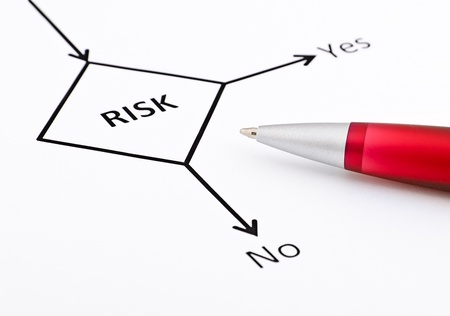Doctors' Risk Attitude
Risk attitude is known to vary substantially across individuals. Some individuals are very risk averse and tend to make safe choices (e.g. investing in a bond) whilst others are more risk seeking and are more comfortable with risky choices (e.g. investing in the stock market). Clinical decisions generally involve risks and the risk attitude of the doctor (and the patient) is therefore important. For example, women with a BRCA gene mutation are believed to have a higher risk of breast cancer. Treatment options include frequent cancer screening which is less invasive but associated with a higher risk of developing breast cancer. Alternatively, a preventive mastectomy can be performed which greatly reduces the risk of developing breast cancer but is invasive. Which of the two options is preferred will in part depend on the individual’s risk attitude.

Evidence on risk attitude and clinical decision making
A doctor’s risk attitude can influence a range of clinical decisions: compared with risk seeking doctors, risk-averse doctors have been shown to order more laboratory tests (i), admit more patients (ii), and use more resources (iii) when delivering healthcare services.
Standard economic theory assumes that an individual’s risk attitude remains stable over time. This means that the risk attitude observed in an individual today is the same as the risk attitude observed in the same individual in ten years’ time. This assumption is however often challenged. Empirical evidence suggests that shocks like economic downturns (iv, v), natural disasters (vi, vii), violent conflicts (viii, ix) and adverse health events (x) can change an individual’s risk attitude. A pandemic like COVID-19 may therefore change doctors’ risk attitudes.
What are the potential implications of a change in risk attitude?
After a shock doctors may become more risk averse and use more resources, for example, by admitting more patients, ordering more tests and maintaining lower hospital bed turnover rate. Alternatively, they may become more risk seeking and less likely to admit patients. It is therefore important to understand whether shocks influence doctors’ risk attitudes. The empirical literature has mainly focused on the general population and little is known about the stability of risk attitude amongst doctors.
Our findings
We use a unique data set from a panel survey of physicians in Australia (MABEL) to examine the stability of risk attitude among doctors. We examined the impact of shocks (negative life events) on risk attitude. A wide range of shocks are examined: injury or illness, bereavement, victim of physical violence, medical negligence claim and property crime. Risk attitude is measured in three domains: financial (e.g. investment with an uncertain outcome), career and professional (e.g. publicly challenging your professional colleagues), and clinical (e.g. recommending a treatment that is new to the usual practice or is controversial). These life events are different from a pandemic but will provide insights into the impact of shocks on risk attitudes.
The results show that risk attitude is stable over a four year time period. It is noted that four years is a relatively short time period, and that over a longer time horizon, it is possible that changes in risk attitude may be observed.
As for the impact of shocks on risk attitudes, we find that financial and career risk attitudes remain stable after health, family and career shocks. However, clinical risk attitude is more sensitive to life events, especially shocks that affect others, such as family death and illness. Our findings show that doctors become more risk seeking after experiencing shocks. This change could influence clinical decision making. It is therefore important that our understanding of risk attitude in doctors’ clinical decision making is improved.
References
i. Holtgrave, D. R., Lawler, F. and Spann, S. J. (1991) ‘Physicians’ risk attitudes, laboratory usage, and referral decisions: the case of an academic family practice center’, Medical Decision Making, 11(2), 125–130. [back to text]
ii. Pines, J. M. et al. (2010) ‘The effect of physician risk tolerance and the presence of an observation unit on decision making for ED patients with chest pain’, American Journal of Emergency Medicine, 28(7), 771–779. [back to text]
iii. Allison, J. J. et al. (1998) ‘The association of physician attitudes about uncertainty and risk taking with resource use in a Medicare HMO’, Medical Decision Making, 18(3), 320–329. [back to text]
iv. Malmendier, U. and Nagel, S. (2011) ‘Depression babies: do macroeconomic experiences affect risk taking?’, Quarterly Journal of Economics, 126(1), 373–416. [back to text]
v. Guiso, L., Sapienza, P. and Zingales, L. (2013) ‘Time varying risk aversion’, Journal of Financial Economics, 128(3), 403-421. [back to text]
vi. Hanaoka, C., Shigeoka, H. and Watanabe, Y. (2014) ‘Do risk preferences change? Evidence from the Great East Japan Earthquake’, Available at SSRN. [back to text]
vii. Cassar, A., Healy, A. and von Kessler, C. (2017) ‘Trust, risk, and time preferences after a natural disaster: experimental evidence from Thailand’, World Development, 94, 90–105. [back to text]
viii. Voors, M. J. et al. (2012) ‘Violent conflict and behavior: a field experiment in Burundi’, American Economic Review, 102(2), 941–964. [back to text]
ix. Moya, A. (2018) ‘Violence, psychological trauma, and risk attitudes: evidence from victims of violence in Colombia’, Journal of Development Economics, 131, 15–27. [back to text]
x. Decker, S. and Schmitz, H. (2016) ‘Health shocks and risk aversion’, Journal of Health Economics, 50, 156–170. [back to text]
Many thanks to Xuemin Zhu for her work developing this Blog post. Xuemin is a third year PhD student in HERU. Her thesis is on The role of the physician’s risk attitudes and personality in clinical and career decision making.

HERU is supported by the Chief Scientist Office (CSO) of the Scottish Government Health and Social Care Directorates (SGHSC). The views expressed here are those of the Unit and not necessarily those of the CSO.


